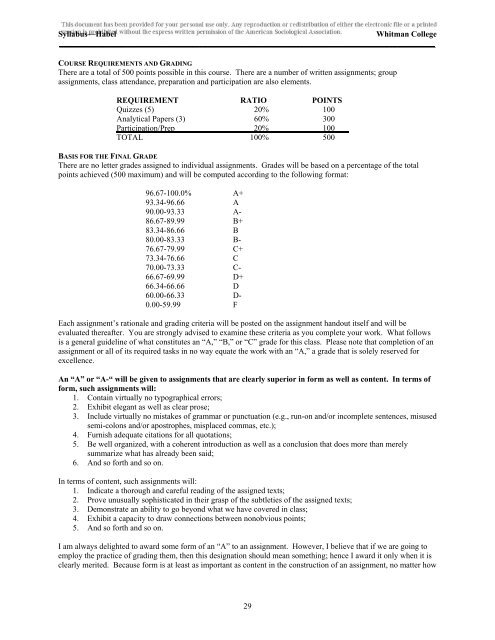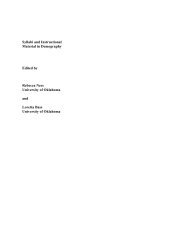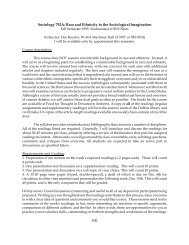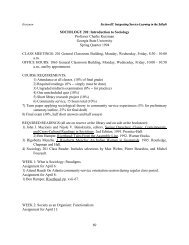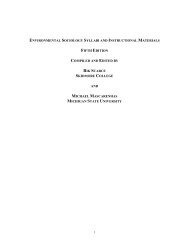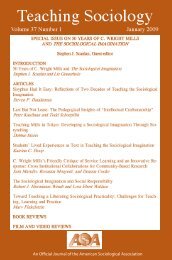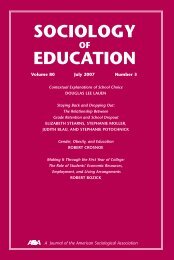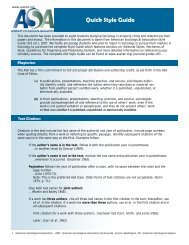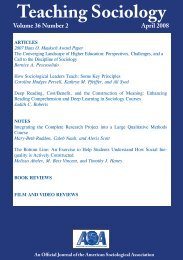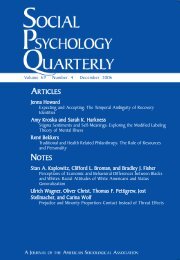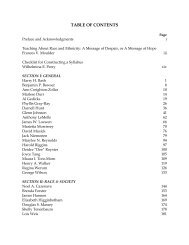Social Problems - American Sociological Association
Social Problems - American Sociological Association
Social Problems - American Sociological Association
Create successful ePaper yourself
Turn your PDF publications into a flip-book with our unique Google optimized e-Paper software.
Syllabus—Habel Whitman College<br />
_____________________________________________________________________________________________<br />
COURSE REQUIREMENTS AND GRADING<br />
There are a total of 500 points possible in this course. There are a number of written assignments; group<br />
assignments, class attendance, preparation and participation are also elements.<br />
REQUIREMENT RATIO POINTS<br />
Quizzes (5) 20% 100<br />
Analytical Papers (3) 60% 300<br />
Participation/Prep 20% 100<br />
TOTAL 100% 500<br />
BASIS FOR THE FINAL GRADE<br />
There are no letter grades assigned to individual assignments. Grades will be based on a percentage of the total<br />
points achieved (500 maximum) and will be computed according to the following format:<br />
96.67-100.0% A+<br />
93.34-96.66 A<br />
90.00-93.33 A-<br />
86.67-89.99 B+<br />
83.34-86.66 B<br />
80.00-83.33 B-<br />
76.67-79.99 C+<br />
73.34-76.66 C<br />
70.00-73.33 C-<br />
66.67-69.99 D+<br />
66.34-66.66 D<br />
60.00-66.33 D-<br />
0.00-59.99 F<br />
Each assignment’s rationale and grading criteria will be posted on the assignment handout itself and will be<br />
evaluated thereafter. You are strongly advised to examine these criteria as you complete your work. What follows<br />
is a general guideline of what constitutes an “A,” “B,” or “C” grade for this class. Please note that completion of an<br />
assignment or all of its required tasks in no way equate the work with an “A,” a grade that is solely reserved for<br />
excellence.<br />
An “A” or “A-“ will be given to assignments that are clearly superior in form as well as content. In terms of<br />
form, such assignments will:<br />
1. Contain virtually no typographical errors;<br />
2. Exhibit elegant as well as clear prose;<br />
3. Include virtually no mistakes of grammar or punctuation (e.g., run-on and/or incomplete sentences, misused<br />
semi-colons and/or apostrophes, misplaced commas, etc.);<br />
4. Furnish adequate citations for all quotations;<br />
5. Be well organized, with a coherent introduction as well as a conclusion that does more than merely<br />
summarize what has already been said;<br />
6. And so forth and so on.<br />
In terms of content, such assignments will:<br />
1. Indicate a thorough and careful reading of the assigned texts;<br />
2. Prove unusually sophisticated in their grasp of the subtleties of the assigned texts;<br />
3. Demonstrate an ability to go beyond what we have covered in class;<br />
4. Exhibit a capacity to draw connections between nonobvious points;<br />
5. And so forth and so on.<br />
I am always delighted to award some form of an “A” to an assignment. However, I believe that if we are going to<br />
employ the practice of grading them, then this designation should mean something; hence I award it only when it is<br />
clearly merited. Because form is at least as important as content in the construction of an assignment, no matter how<br />
29


